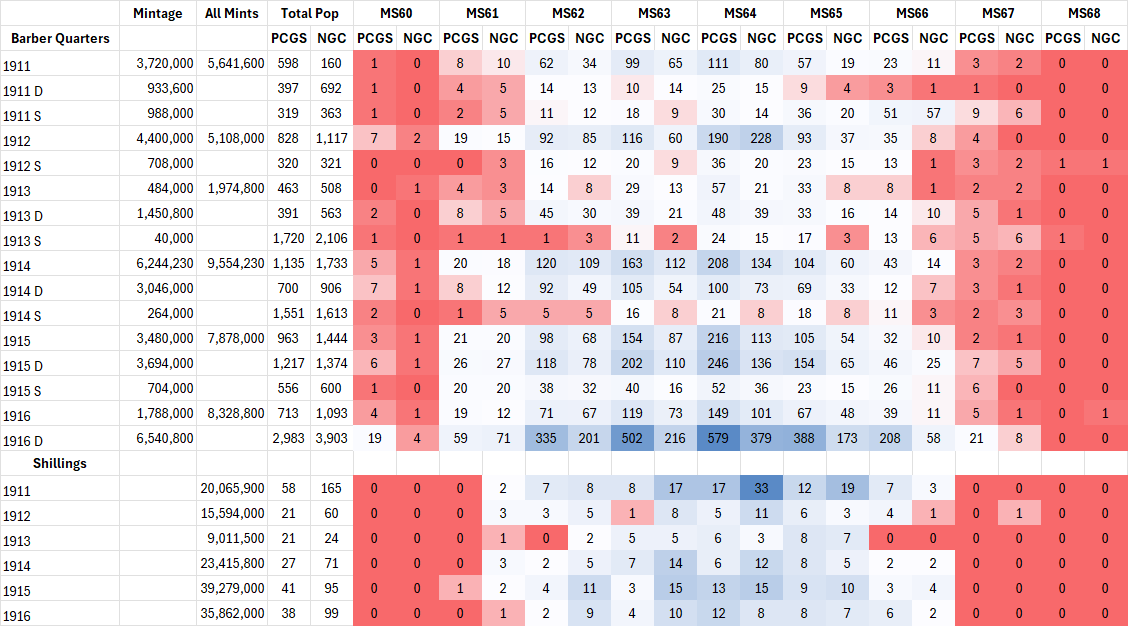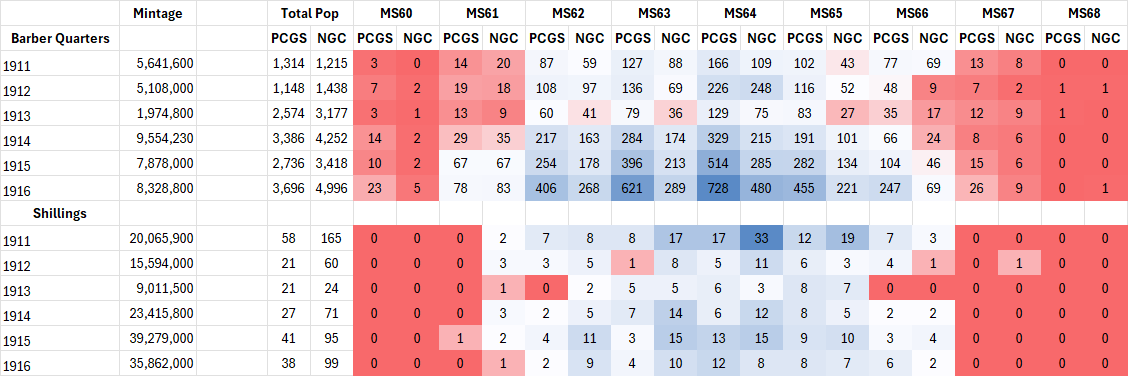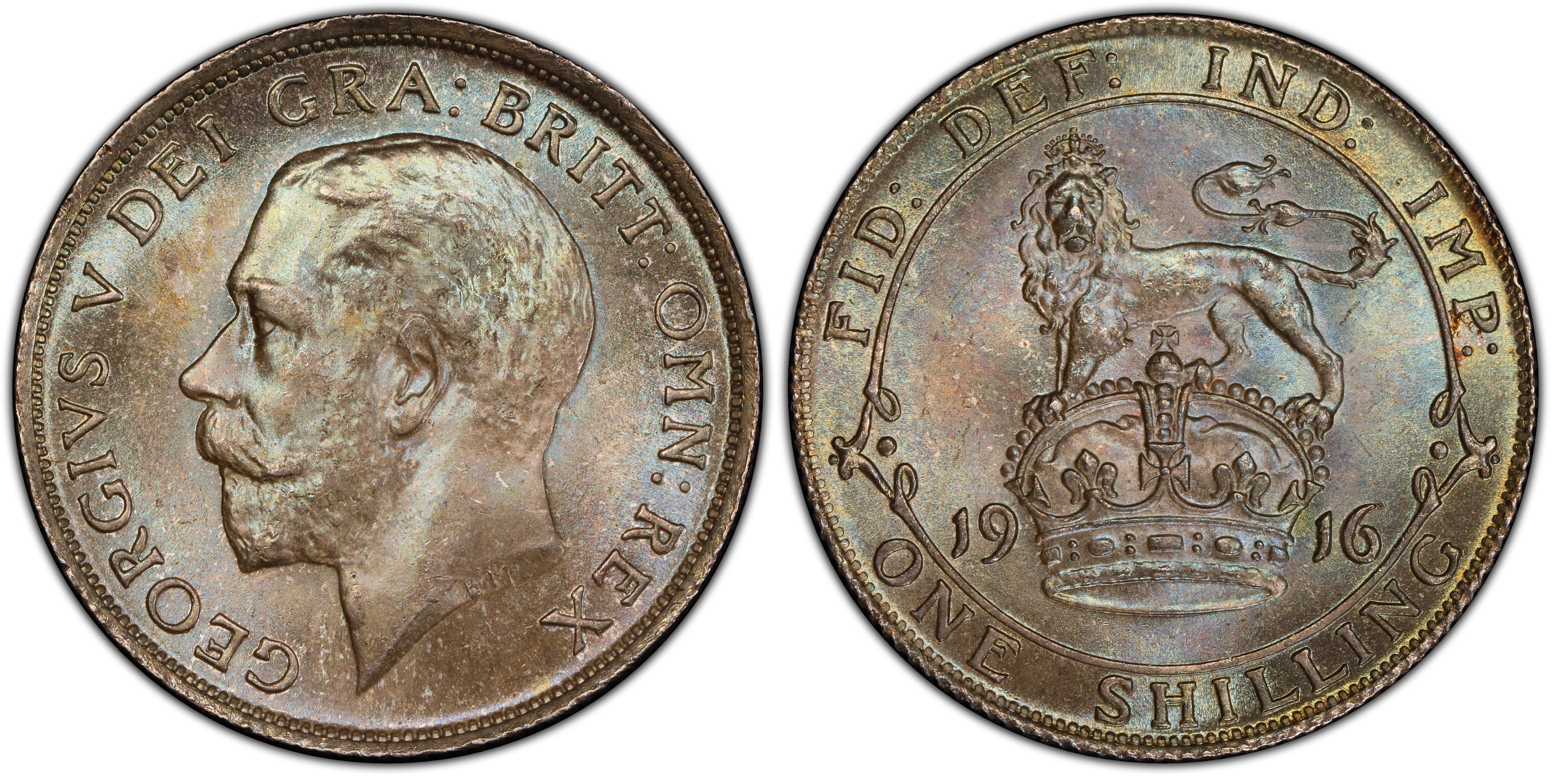Apples to Oranges: A Fruitless Exercise in Numismatic Analysis
 Clio
Posts: 612 ✭✭✭✭✭
Clio
Posts: 612 ✭✭✭✭✭
One of the parallels I can't help but consider when collecting UK coinage is how it compares to US coinage. I want to say right here and now before I continue that I understand there's many flaws to trying to make this side-by-side comparisons hence the title.
What am I rambling on about today? Specifically comparing the George V Shillings series to the Barber quarters minted in similar time periods. There's a lot of political or cultural impacts I have no way of accounting for. Whether the UK had more difficulty sourcing material or maybe the coins in circulation were abundant enough to not need a high mintage. I don't know. I am just mentioning those factors might impact this and I have no way of accounting for them. This all started because of how I felt attempting to build sets. I frequently felt like the George V material on the market was scarce or just generally lower grade than the US counterparts and wanted to be justified somehow.
Initial thoughts:
UK Coinage has less survival in high grade than US. - My speculation being that US collectors collected modern series more frequently and as a direct result have played a role in the survival of our coinage in high grade. I have often considered the existence of early Whitman folders to be an important piece to this puzzle. I also suspect that the percentage of collectors for this modern material to be far greater in the US than in a country with 2,000+ years of coinage history.
UK Coinage has a lower top end than US grade wise. - My speculation being how the coinage was handled at the mint if there's a possibility, they sustained more contact marks and heavy handling than the US coinage.
If you have any insight in either of those thoughts, please share below.
Now let's talk about the years/series to compare.
First off Shillings are not the same value as quarters.
Quarters 6.25g 90% Silver or 5.625g of silver
Shillings 5.66g 92.5% Silver or 5.2355g of silver
I am not sure what the implications of this is other than that there's the potential that more shillings had to be minted to represent the same value as the US quarter. Maybe it means that the shillings would circulate more for being small change in comparison. Maybe I am overthinking it. Infact I am confident I am overthinking it.
Second thing to note is the mintages. Considering how it feels collecting these I would've thought the mintages would be closer in number but, oh no-no-no. There were substantially more shillings minted. As an example, in 1915 there were 7,878,000 Barber quarters issued to 39,279,000 Shillings issued. Now I am aware that is a single year and using only a single year is unfair.
Third issue is the years to compare. The shilling series I collect overlaps both barber coinage and standing liberty coinage. However, the issues that were full sterling were only until 1919. This is what leads me to doing a short comparison of just the years 1911 to 1916 leaving off the SLQs entirely. The early 50% shillings had production issues that I wouldn't want to skew our observations anyway.
So now let's get to my data. What data you ask? Pop reports of course!
Collective groan among the coin community
I know, I know. It's really all I have. I am aware of the downfalls of it, but I choose to use it anyway. The main reason to use it is not because of the number of pops but the proportions. Given enough data, trends should bear out a pattern or trend to analyze. Whether it's accurate or useful? Who knows, who cares. Sometimes you do something because it seems fun and then you're 635 words into a nerd ramble on an internet forum about to upset an entire faction of the community.
Data time.

Wow. Already I was not ready for this harsh truth. The data really shows the pop proportions to be much closer than I initially expected.
Let's look at the same but combine all the US mints for some easier viewing.

Part of my initial thoughts was that US coinage had just tons of MS68s and MS67s. In comparison believing that the single MS67 shilling was not a significant comparison but it really is much closer than expected.
720 graded GVs
Vs
33,350 barber quarters graded
1 GV shilling in 67
vs
121 barbers in 67
Within a margin of error really.
If we consider how many coins have been graded of the barber quarters and assume the rate would be the same before a MS68 is found in GV Shillings, then that means we need to grade 7,617 more shillings before we see our first 68. So now the pops start to make more sense really.
What does all this mean? Namely that my initial instincts were probably wrong. Our data is far from perfect, but it still makes for an interesting picture.
Closing thoughts.
UK Coinage has less survival in high grade than US. Difficult to prove one way or another considering the lack of grading vigor in the UK compared to the US.
UK Coinage has a lower top end than US grade wise. Not necessarily true. Data shows them align more than expected with the issue again being the number of coins graded.
Curious the forums thoughts on all this. I wish I had a better way to compare but at least I have something beyond reporting on general vibes. Maybe I should just stick with vibes over data. I do like a good spreadsheet though.
Here's a picture of a shilling

https://numismaticmuse.com/ My Web Gallery
The best collecting goals lie right on the border between the possible and the impossible. - Andy Lustig, "MrEureka"
Comments
What are you defining as "high" grade?
Are you trying to compare in MS, a minimum MS grade, or your "eye' appeal" preference?
Really 66,67,68. Those are the grades that have most eluded me to the point I was curious if there was a clear distinction between US and UK coinage of the same time period.
https://numismaticmuse.com/ My Web Gallery
The best collecting goals lie right on the border between the possible and the impossible. - Andy Lustig, "MrEureka"
I think you're trying to quantify what's almost entirely random survival.
I previously posted a list which can be used for this purpose, but I wouldn't claim it provides much accuracy or indication for these TPG grades.
Subject to mintage difference, in comparable TPG grade, I'd expect most UK coinage of this period (1911-1936) to be more common or a lot more common vs. any earlier US series except Morgan dollars and generic US gold, but again, not necessarily in these grades.
My inference is KGV Shillings are probably scarcer in this grade (or higher) vs SLQ. This is still contingent upon the limited preference for TPG in the UK (which I presume is still the primary market for this coinage) and relative prices.
@Clio
While I agree with your generalizations, I suppose I get there by taking a different path.
I don’t see the pop reports for a smaller section going from 1911-1916 for Barbers and KGV as a reflective sample to make the argument. There are in my view some threshold issues at stake:
There has to be a compelling reason to submit coins based on value and maximizing value through the submission. And there really must be wider valuation increments to support/encourage submission for KGV. And I really do not see the incentive for the KGV shillings to be submitted as opposed to Barbers.
The collector base is different as the Barber collectors seeking coins across the spectrum whereas KGV collectors primarily seek MS examples.
Using a greater time frame for your comparison to include Edward VII shillings as there is a much greater financial incentive to submit shillings from his reign. And these shillings are tougher in GEM… more so than KGV. The quality of the Edward VII is more challenging to meet expectations of GEM status. So by expanding the date range, the argument as to condition rarity should clearly favor the shilling over the Barber Quarter.
Just for fun, compare the surviving MS population for the 1908 and 1909 shilling to the rare dates within the Barber series. While one can argue it is not an apples to apples comparison based on the difference in collecting culture between the US and UK, I suspect some might still be surprised as at how few of these were saved. And to compare GEMs at 65 and higher would be the icing on the cake to establish the rarity of the Edward VII shillings.
In the late 1890s though the end of the reign of Edward VII, there was a greater interest in ancients among coin collectors and fewer mint state examples were saved. And this was a problem across the board… negatively impacting multiple series from both the UK and US and even Canada during this time. This in part helps explain the condition rarity for various dates. I know this is about shillings… but that look at the graded population for some of the Edward VII Florins. These simply were not saved in quantity at the time of issue.
Experience the World through Numismatics...it's more than you can imagine.
In MS-66 to MS-68 grades, I don't think it's primarily the absolute number set aside. I would think it would mostly be how well the coins were initially made which I don't know that well. These coins were pocket change at the time, so I don't see it as a trade-off with collecting ancients, despite the greater purchasing power at the time. Only people of some means could afford to collect in either the UK or US.
There are hoards (large and small) in much better surviving quality than practically all collectors would expect for all kinds of coins with a miniscule probability of surviving vs. any late 19th century/early 20th century UK coin. Not just ancients either. I don't specifically know of any, but far more likely a hoard of Barber coinage or Edward VII/KGV shillings vs. the ones I know, like the 1540's Mexico Carlos & Johanna 4R ("late series") in AU/lower MS.
The differences in the TPG populations between Barber coinage and these shillings is almost certainly not reflective of the relative scarcity. Barber coinage is worth more or a lot more (usually if not always) and US collectors have a much greater preference for TPG. I don't share the same views as others on this forum on the propensity for duplicates in the TPG counts, but the higher value makes it more likely for Barber coinage as well.
Well I love the Brit silver series from Vicky forward to be sure and might be thought of on that basis as biased HOWEVER I just think they are too different to draw any comparisons & agree with much of what WCC has said. An interesting bit of charting by the OP.
Somewhere there is video footage of Brit silver coins being struck and then rumbling and banging their way down a long chute into what I recall were basically buckets. So they may have had a bit rougher treatment.
I agree that there is virtually no interest in coins in less than mint state, even including a "key" such as the 1905 whereas the same can not really be said of Barbers.
Also, collectors of Brit coins in the home country still don't care a lot for TPG slabbing in the case of these coins. Also, they are a relatively unloved series with no mintmarks and precious few/no varieties of real note. One look at the Barber post over on the US coins side of this forum shows the enthusiasm for virtually all of them.
I must say, I know of a few extreme rarities (shall we say) and they do not bring even the merest fraction of what a Barber of similar significance would - oh that it were so!
Well, just Love coins, period.
Don't forget, these coins were not made for use just in Britain itself, but most British colonies also used regular British coinage. The Sterling-using parts of the British Empire were much bigger than the US in 1915, in terms of population.
There is another fundamental factor to consider: the designs of the coins themselves, and how well that design stands up to being jostled about. Some coins are simply better at keeping themselves in high grade than others. A coin with a deep high rim will keep itself better than a coin with little or no rim, for example. And a coin design that's very "busy", with very little plain empty field space in the background, will tend to "look better" and thence grade better than an equally-dinted coin with large open field areas that are magnets for eye-catching bag marks. The George V shillings, in particular, have lots of blank field areas to collect bag marks, compared with a Barber quarter, so I would expect them to be more difficult to preserve in higher grade.
Ordinarily, composition would be another factor in how well a coin "keeps"; but I don;t think .900 fine silver is significantly different in toughness or ductility compared to .925 silver for that to make much of a difference.
Finally, the TPG pop reports for British coins are going to be skewed by the different collecting culture, when it comes to slabbing. In the US, anyone who has owned a really nice high-grade coin for the past few decades will have faced considerable pressure to get it slabbed, and thus a large proportion of the surviving high-grade coins are going to already be slabbed. In Britain, this simply isn't true. Most of the super-high-grade British coins are still sitting around raw. The lack of a "slabbing culture" among British collectors, combined with the increased costs, time and risk involved in shipping your coins overseas to be slabbed, is likely to keep this true for a while into the future.
Roman emperor Marcus Aurelius, "Meditations"
Apparently I have been awarded the DPOTD twice.
This is certainly true and I have mentioned as much above in my initial post however, coins are still being slabbed so the idea that the grades fall within a certain proportion is what I was looking to observe. IE 80% submitted are below MS65 vs 70% of Barbers (I just made the numbers up here). If anything the argument that the Shillings are worth less submitting should suggest that only the highest grades are submitted but that's clearly not true as there's plenty of 62/63s submitted which are not financially worthwhile to submit. Worth noting my comparisons above are only taking into account MS coins not the AU and below examples.
https://numismaticmuse.com/ My Web Gallery
The best collecting goals lie right on the border between the possible and the impossible. - Andy Lustig, "MrEureka"
I’m not very active on these forums but I collect UK coins and have lovely Victoria and Edward VII type collections. I used to have a George V and George VI type collection but moved on from those because I thought those coins were easier to find in high grade, although that has changed in recent years. But I’ve noticed that some UK coins have amazing original toning, likely from tissue paper or a proper velvet case, while U.S. coins from the Seated through Barber period are much, much harder to find with attractive toning in high grades. It’s a case of technical grade versus eye appeal. I think there were more British coin collectors than American coin collectors 100-150 years ago but also, it’s really tough to grade at the highest end of the scale, and maybe British collectors prioritized those higher eye appeal coins (even if technically MS64-ish) over higher technical grades. But it’s a great question.
Lacking specific numbers, I'd think so too, but I don't think the number in either country was that low even during the years of the Barber series. The number of proofs sold for Barber nickels and IHC is really low compared to 1950 and later US sets, but US proof mintages are an outlier vs. everywhere else. My assumption is that the number of active more than casual collectors at the time presumably was a low multiple in the US to the number buying any proof coin, but the coins they set aside in this type of quality just didn't survive in this state to the present.